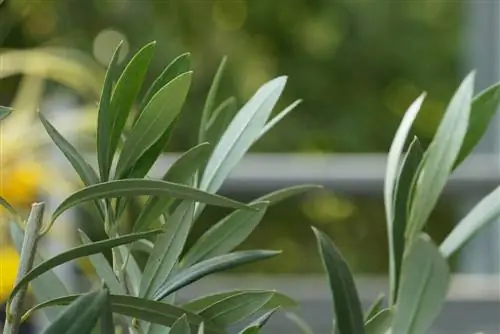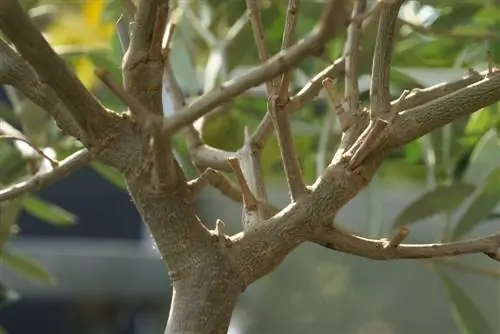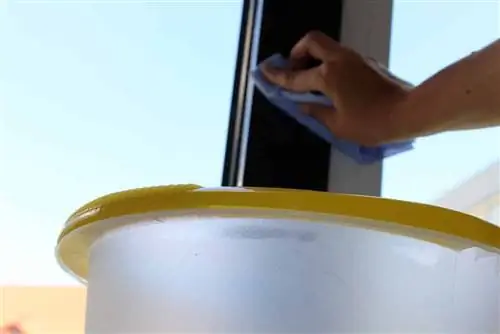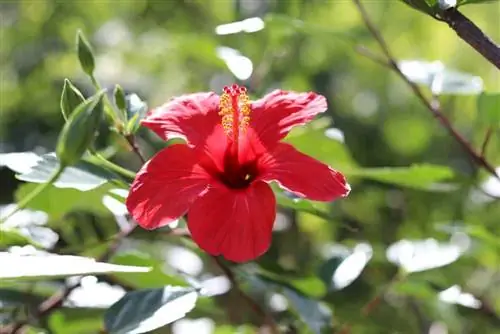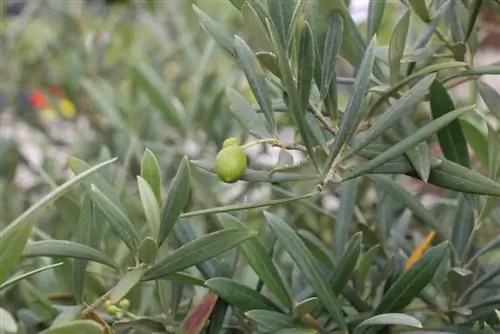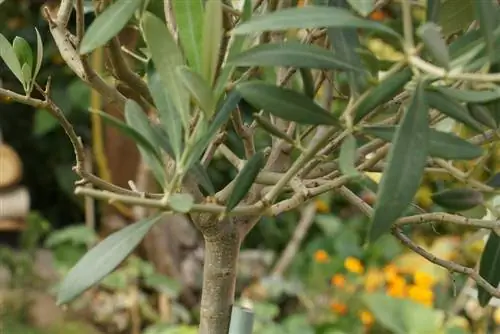- Author admin [email protected].
- Public 2023-12-17 03:39.
- Last modified 2025-01-24 12:45.
The olive tree has become the undisputed leader in the Mediterranean garden. With its gnarled shape, evergreen foliage and unique fruits, it speaks of the floral opulence of the Mediterranean. While you have to follow the laws of nature when cultivating citrus plants and provide winter quarters for the pots, an olive tree may not bow to these laws. Thanks to its limited winter hardiness, the pretty tree can overwinter outside. However, it should not be treated like a native garden plant. These instructions explain how an olive tree in a bed and pot can survive frost and cold undamaged.
Mild winter regions allow outdoor cultivation
The lower limit of its winter hardiness is -10 degrees Celsius. Planting an olive tree in a bed therefore does not have a chance of success in all regions of Germany. If your garden is in a wine-growing region, on the Lower Rhine or a similarly mild winter region, there is nothing to stop you cultivating it outdoors. Please remember that just one night of bitter frost is enough to cause serious damage to your Mediterranean piece of jewelry.
In the high altitudes of the low mountain ranges and wherever the mercury column falls below the temperature minimum, cultivation in buckets becomes the focus. Thanks to the resulting mobility, the exotic animal can be relocated to a suitable winter location that is not necessarily behind glass. The following instructions for problem-free wintering examine all options in detail.
Winter hardiness zone serves as orientation
Are you unsure whether your garden is in a suitable region for planting olive trees? Then a look at the assignment to the winter hardiness zone will help you make a decision. A total of 11 winter hardiness zones have the task of mapping the different course of the cold season by region. The range extends from Z1 for temperatures below -45.5 degrees Celsius to Z11 for frost-free winters above +4.4 degrees Celsius. Interesting for the olive tree gardener is Z8 with temperatures between -6.7 to -12.3 degrees Celsius, as the Lower Rhine as well as southern France and Spain, the home countries of numerous olive varieties, are subject to this classification.
If in doubt, take a map with the corresponding division into winter hardiness zones. If your garden falls under Z8 to Z11, you have the privilege of planting an olive tree in the bed.
Winter protection in the bed
In its habitat, the olive tree has adapted to a dry, hot climate, which sometimes cools down to below freezing point at high altitudes in winter. There is one weather condition that the exotic car does not take into account: the wet and cold weather of the typical German winter outside of high altitudes. Proper winter protection in the bed protects the olive tree plant from both cold and moisture. Under the influence of constant rain, even in the most permeable garden soil, it cannot be assumed that all water will seep away quickly. The resulting waterlogging poses an even greater threat than freezing temperatures. With these precautions, your olive tree will overwinter in the bed he althy and happy:
- The trunk and crown are covered with several layers of breathable, translucent fleece
- Very large tree slices are covered with a 20 to 30 cm thick layer of autumn leaves or straw
- Fix the leaf layer with pine fronds or brushwood
- Cover smaller tree slices with a protective cork mat
- Wrap the trunk several times with a raffia mat and cover the crown with a fleece cap
Close the hood all the way down to the ground so that it is windproof. For large and small olive trees, specialist retailers have suitable fleece covers with a zip for this purpose. These are then tied up near the ground.
Please do not use foil as a winter coat for your olive tree. Since the material is not permeable to air, condensation develops as a result of temperature fluctuations. Rot and mold are inevitable when there is too much moisture, making it easy for diseases and pests. Sufficient light must also penetrate, otherwise the tree will drop its leaves.

Tip:
You can equip a planted olive tree with special floor heating. In this case, it must be ensured that the earth does not warm up so much that the tree sprouts. The result would be more significant frost damage than without an additional heat source.
Instructions for wintering in the bucket
There is not always winter quarters with the appropriate space available for a large olive tree in a pot. That's no reason to forego the Mediterranean character in the garden and on the balcony. Wherever the temperature minimum of -10 degrees Celsius at night is not significantly below, a real olive tree can survive frost and cold with the help of these measures:
- Cover a wooden box on the ground with a layer of bark mulch
- Place the bucket in the middle
- Fill the cavities all around with bark mulch or stuff with straw
- Cover the substrate with leaves or wood shavings
- Equip the crown with a translucent and breathable hood
Place the wooden box in front of a protective house wall or in a wall niche before placing the bucket with the olive tree in it. In such a location, the tree benefits from the waste heat from the house. Ideally, a canopy keeps pelting rain away from the plant.
If the pot and tree are too large to be lifted into a wooden box, place the container on a plant roller made of a cold-insulating material, such as wood, before planting. You can line this with straw, foil or old blankets after the first frost. Wrap the pot thickly in several layers of bubble wrap. Leaves on the substrate and a cover for the trunk and crown round off the winter protection.
Tips for the optimal winter quarters
A Mediterranean garden with olive trees does not have to remain a pipe dream in harsh winter mountain locations where temperatures regularly fall below -10 degrees Celsius. Cultivated in an authentic terracotta pot, the symbolic tree spreads its exotic flair throughout the summer. If a room with the following conditions is available for the winter time, you can accompany the exotic animal through the cold season:
- Only clear up when frost sets in
- Ideally place in a bright, cool location at 5 to 10 degrees Celsius
- From 12 degrees Celsius, compensate for the lack of light with plant lamps
- Air the room regularly, without cold drafts
- Wate very sparingly
- Do not apply fertilizer from November to March
An unheated winter garden, a bright staircase or a light-flooded garage are ideal for winter quarters. Low temperatures are mandatory in a dark room. Nevertheless, the real olive tree sheds its leaves under these conditions. At the beginning of spring, budding begins. The associated effort required for the already stressed olive tree makes this option the worst option for overwintering.

Tip:
Overwintering tents are a sensible alternative to winter quarters. These are equipped with a frost monitor and can be placed on the balcony or terrace.
Golden mean between bed and pot
To transform the garden outside winter hardiness zone 8 into a picturesque olive grove or to create a spectacular eye-catcher with a solitary olive tree, you have a clever compromise solution at your disposal. Planting out is combined with overwintering behind glass. To do this, place the tree and its container in the ground in a sunny, warm location. Ideally, the vessel is equipped with two handles. If winter is just around the corner, lift the oversummer olive tree out of the ground. The tree survives frost and cold in the bright, frost-free winter quarters, as described in detail in these instructions.
Winter out early
So that your olive tree can absorb the maximum amount of fresh air and sunshine, move it back outdoors as early as possible. If the weather is normal, clear out the bucket in mid/late March. At this time, all protective measures in the bed can also be removed. If light frosts occur in spring, the tree can cope with them without any problems.
In the pot, a real olive tree should not suddenly move from its winter quarters to the blazing sun. By initially placing the plant in a partially shaded, protected location for 8 to 10 days, sufficient acclimatization is guaranteed. Thanks to this care, sunburn can be avoided in the sunny spot in the garden and on the balcony.
Varieties with an extra portion of winter hardiness
The olive tree is native to the Mediterranean. Its distribution area therefore extends across regions with different climatic conditions. By choosing an olive tree variety whose habitat is as close as possible to the Central European climate, you optimize the chances of an undamaged overwintering in your garden.
The following selection introduces you to robust varieties:
Cornicabra (hardy to -13 degrees Celsius)
The olive tree, native to Spain, supplies about 12 percent of Spain's total olive oil production. Its winter hardiness has been proven in scientific field tests.
Arbequina (hardy to -11.8 degrees Celsius)
This variety is one of the few olive trees whose fruits are suitable for both consumption and processing into oil. The small, brown olives are native to Catalonia and Aragon. The robust frost tolerance was confirmed by scientists at the University of Cordoba.
Hojblanca (hardy to -9.9 degrees Celsius)
The central habitat of this olive variety is in the Spanish province of Cordoba. Hojblanca is one of the olive trees whose winter hardiness has been examined and confirmed by the University of Madrid. Its olives are valued throughout Europe as oil due to their slightly bitter taste.
Empeltre (hardy to -9.5 degrees Celsius)
If you are looking for an olive tree that produces medium-sized, black olives and is also hardy, Empeltre is the right choice for you. Anyone who spends their vacation on the Balearic Islands is already familiar with its rustic appearance because the variety is native here.
Gemlik (hardy to -9.5 degrees Celsius)
The Gemlik olive provides convincing evidence that hardy olive varieties are not limited to a Spanish origin. The variety is named after the city of Gemlik, which is about 90 km away from Istanbul. The small to medium-sized, black fruits have a high oil content. They can often be found on breakfast tables because they can also be eaten fresh.
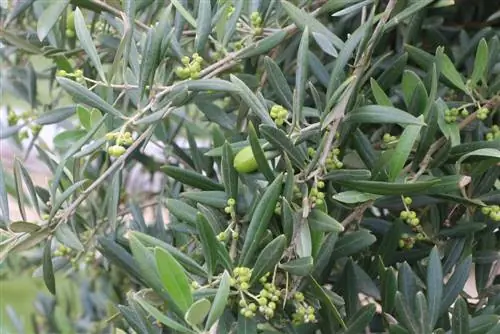
Tip:
If a young olive tree comes from a regional tree nursery, it can adapt excellently to winter conditions outdoors. Shipping a full-grown tree from the Mediterranean to Germany, planting it out and hoping for a successful overwintering has no chance of success.
Conclusion
Thanks to its limited winter hardiness, the olive tree is very popular for designing the Mediterranean garden. Wherever the winter temperature minimum of -10 degrees Celsius is not exceeded, the gnarled character can even be planted in the bed. In all other cases, the real olive tree thrives in a pot in the open air from spring until the onset of winter. As this guide explains in detail, careful protective measures will ensure that the robust exotic will survive frost and cold without any problems. Outside winter hardiness zone Z8, this southern gem will accompany you through the cold season in bright, frost-free winter quarters. If you choose an explicitly winter-hardy olive variety when purchasing, you will optimize your chances of successful wintering.

